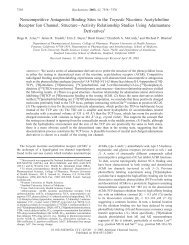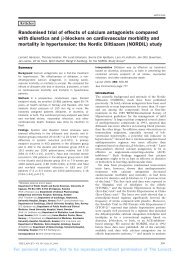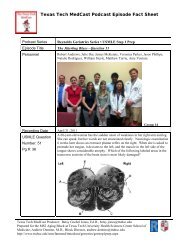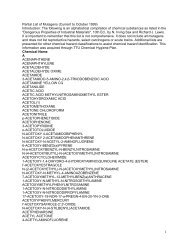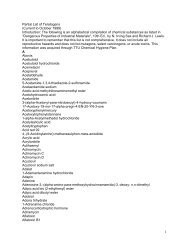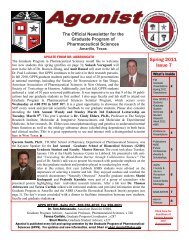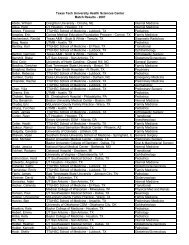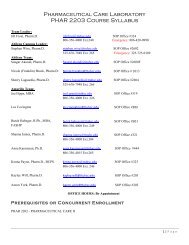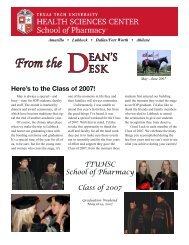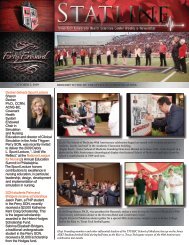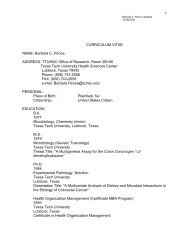Dermatology - Texas Tech University Health Sciences Center
Dermatology - Texas Tech University Health Sciences Center
Dermatology - Texas Tech University Health Sciences Center
You also want an ePaper? Increase the reach of your titles
YUMPU automatically turns print PDFs into web optimized ePapers that Google loves.
Department of Internal Medicine<br />
<strong>Texas</strong> <strong>Tech</strong> <strong>University</strong> <strong>Health</strong> <strong>Sciences</strong> <strong>Center</strong><br />
Odessa, <strong>Texas</strong><br />
<strong>Dermatology</strong> Elective Curriculum<br />
Revision Date: July 10, 2006<br />
Approved by Curriculum Meeting June 30, 2006<br />
I. Educational Purpose: This elective rotation is designed to teach the resident the<br />
fundamentals of diagnosis and management of commonly encountered dermatological<br />
disorders. The major emphasis will be on the diagnosis and treatment of the most commonly<br />
encountered skin lesions such as acne, skin cancer, and allergic reactions. The resident will<br />
learn the standard terminology used is describing skin lesions.<br />
II. Rationale: Skin lesions are encountered in every patient; no individual has flawless skin. It is,<br />
therefore, important to identify those lesions that do not need treatment, those than can be<br />
treated by the general internist, and those that should be referred to a dermatologist.<br />
III. Knowledge/Objectives:<br />
A. The resident should be able to recognize the range of presentations of common skin<br />
conditions:<br />
a. Psoriasis<br />
b. Acne<br />
c. Drug eruption<br />
d. Verrucae<br />
e. Tinea<br />
f. Seborrheic dermatitis<br />
g. Contact dermatitis<br />
h. Actinic keratoses<br />
i. Based cell carcinoma<br />
j. Nevi<br />
k. Hair loss<br />
l. Pyoderma<br />
m. Urticaria<br />
B. The resident will learn the dermatological history including:<br />
a. Medications<br />
b. Exposure to contactants – tape, detergents, industrial, insect bite(s), etc.<br />
c. Progression of lesions<br />
d. Sexual history<br />
C. The resident will learn clues to less common skin diseases:<br />
a. Location of lesions<br />
b. Age of patient<br />
c. Color of lesions<br />
d. Special lesions<br />
e. Descriptive pointers<br />
1
IV.<br />
Teaching Methods:<br />
A. Patient encounters in private dermatology offices.<br />
B. Didactic lectures<br />
V. Procedures: The resident should become familiar with the following techniques:<br />
a. KOH examination for fungi<br />
b. Mineral oil scraping for scabies<br />
c. Trephine (punch) biopsy of skin<br />
d. Elliptical excision of skin<br />
e. Subsection (shave) biopsy of skin<br />
f. Liquid nitrogen treatment for warts and keratoses<br />
VI. Educational Goals by Relevant ACGME Competency:<br />
*Legend for learning activities (see above for a description of each activity.<br />
DPC – Direct Patient Contact<br />
DC – <strong>Dermatology</strong> Consultation<br />
ID – Formal Lectures and Individual Discussions<br />
LR – Literature Review<br />
SC – Subspecialty Conferences<br />
DX – <strong>Dermatology</strong> Exam<br />
BR – Board Review<br />
Patient Care:<br />
Principal Educational Goals<br />
Develops skills of comprehensive patient interview and<br />
adequate, timely use of other available data sources<br />
Improve skills of patient examination<br />
Define and prioritize patient’s problems in a timely and<br />
accurate manner<br />
Generate and prioritize pertinent differential diagnosis<br />
Develop rational, evidence-based management<br />
strategies, in accordance with patient’s preferences and<br />
values<br />
Implement and oversee accurate and timely delivery of<br />
management plan, including procedural skills<br />
Actively assure effective continuity of patient care<br />
Capable of timely, accurate and focused verbal and<br />
written communication with all members of the health<br />
care team<br />
Learning Activities*<br />
DPC, FC, BR<br />
DPC, DC<br />
DPC, DC, EX, BR<br />
DPC, DC, ID, LR, EX,<br />
BR<br />
DPC, DC, ID<br />
DPC, DC<br />
DPC, DC, ID<br />
DPC, DC<br />
2
Medical Knowledge:<br />
Principal Educational Goals<br />
Progressively expand clinically applicable knowledge<br />
base of the basic and clinical sciences underlying the<br />
care of the patient with an endocrine disorder<br />
Demonstrate initiative and capability to access and<br />
critically evaluate current medical information and<br />
scientific evidence relevant to patient care<br />
Show comprehensive understanding of complex<br />
relationships, mechanisms of disease<br />
Learning Activities*<br />
DPC, DC, ID, LR,<br />
SC, RR<br />
DPC, DEC<br />
DPC, DC, ID, EX, BR<br />
Practice-Based Learning:<br />
Principal Educational Goals<br />
Constantly evaluates own performance and incorporates<br />
feedback into improvement activities<br />
Identify and readily acknowledge gaps in personal<br />
knowledge and skills in the care of patients with<br />
endocrine disorders<br />
Develop and implement strategies for filling gaps in<br />
knowledge and skills<br />
Effectively uses technology to manage information for<br />
patient care and self-improvement<br />
Learning Activities*<br />
DPC, DC<br />
DPC, DC<br />
DPC, DC, SC, ID<br />
DPC, EC, SC,ID<br />
Interpersonal Skills and Communication:<br />
Principal Educational Goals<br />
Establish a highly effective and timely therapeutic<br />
relationship with patients and families<br />
Communicate effectively with physician colleagues at all<br />
levels<br />
Communicate effectively with all non-physician members<br />
of the health care team to assure comprehensive and<br />
timely care of patients<br />
Present patient information concisely and clearly,<br />
verbally and in writing<br />
Demonstrate excellent education and counseling of<br />
patients, families, and colleagues<br />
Demonstrate excellent education and counseling of<br />
patients, families, and colleagues<br />
Learning Activities*<br />
DPC, DC<br />
DPC, DC, SC, ID<br />
DPC, DC<br />
DPC, DC<br />
DPC, DC<br />
DPC, DC, SC. ID<br />
3
Professionalism:<br />
Principal Educational Goals<br />
Honesty/ Integrity: Is truthful with patients, peers, etc.,<br />
and in professional work (documentation,<br />
communication, presentations, research)<br />
Reliability/ Responsibility: Is accountable to patients,<br />
families, and colleagues. Can be counted on to complete<br />
assigned duties and tasks in a timely manner. Accepts<br />
responsibility for errors<br />
Respectful of others: Talks about and treats all persons<br />
with respect and regard for their individual worth and<br />
dignity; is fair and non-discriminatory. Routinely inquires<br />
about or expresses awareness of the emotional,<br />
personal, family, and cultural influences on patient wellbeing<br />
and their rights and choices of medical care; is<br />
respectful of the other members of the health care team.<br />
Maintains confidentiality.<br />
Compassion/ Empathy: Listens attentively and responds<br />
humanely to patient’s, family members’, and colleagues’<br />
concerns; provides appropriate relief of pain, discomfort,<br />
and anxiety<br />
Self-Improvement: Regularly contributes to patient care<br />
or educational conferences with information from current<br />
professional literature; seeks to learn from errors; aspires<br />
to excellence through self-evaluation and acceptance of<br />
the critiques of others<br />
Self-Awareness/ Knowledge of Limits: Recognizes need<br />
for guidance and supervision when faced with new or<br />
complex responsibility; is insightful of the impact of one’s<br />
behavior on others and cognizant of appropriate<br />
professional boundaries<br />
Communication/ Collaboration: Works cooperatively and<br />
communicates effectively to achieve common patient<br />
care and educational goals of all involved health care<br />
providers<br />
Altruism/ Advocacy: Adheres to best interest of the<br />
patient; puts best interest of the patient above selfinterest<br />
and the interest of other parties<br />
Learning Activities*<br />
All<br />
All<br />
All<br />
All<br />
All<br />
All<br />
All<br />
All<br />
4
System-Based Practice:<br />
Principle Educational Goals<br />
Understand and utilize the multidisciplinary resources<br />
necessary to care optimally for patients<br />
Collaborate effectively with other members of the health<br />
care team to assure comprehensive patient care<br />
Use evidence-based, cost-conscious strategies in the<br />
care of patients with endocrine disorders<br />
Utilize systems-based approaches to reduce errors<br />
Assist in development of systems improvement<br />
Learning Activities*<br />
DPC, DC, SC, ID<br />
DPC, DC, SC<br />
DPC, DC, SC, ID, BR<br />
DPC, DC<br />
DPC, DC<br />
VII. Rotation Specific Competency Objectives<br />
a. Patient Care – By the end of the rotation the resident must be able to complete a<br />
comprehensive history with particular focus paid to dermatologic problems as outlined in<br />
section III. The resident must demonstrate the ability to complete a detailed examination of<br />
the skin. The resident will demonstrate skills in clinical documentation in the medical record.<br />
b. Medical Knowledge – By completion of the rotation, the resident must be able to evaluate<br />
common dermatologic problems including acne, psoriasis, skin cancer, actinic keratoses,<br />
and contact dermatitis. The resident will develop competence in the use of medications to<br />
treat acne and in the use of topical steroids and 5 flurouracil.<br />
c. Interpersonal and Communication Skills – The resident will actively work with the nursing<br />
staff and demonstrate the ability to work in a team setting. The resident will develop and<br />
sustain a therapeutic and ethically sound relationship with patients and their families. The<br />
resident will demonstrate the ability to communicate effectively and demonstrate a caring,<br />
compassionate, and respectful behavior.<br />
d. Professionalism – The resident will demonstrate respect, compassion, and integrity. The<br />
resident will be committed to excellence and continuous professional development.<br />
e. Practice Based Learning and Improvement – The resident will be able to locate, critically<br />
appraise, assimilate evidence from scientific studies to apply to patients’ health problems.<br />
The resident will be able to use information technology to manage information, access online<br />
medical resources to support self-education, patient care decisions and patient<br />
education. The resident will learn the indications as well as the limitations of dermatologic<br />
diagnostic testing.<br />
f. System Based Practice – The resident will be able to practice cost-effective health care<br />
and resource allocation while advocating for quality. The resident will be able to assess,<br />
coordinate, and improve health care and system performance.<br />
5
VIII. Methods of Evaluation: <strong>Dermatology</strong> clinical faculty complete written comprehensive<br />
competency based evaluation forms provided by the residency coordinators. The faculty will<br />
review the evaluation face-to-face with the resident. All evaluations are part of the resident file<br />
and are available for resident review except for those evaluations provident by resident peers.<br />
IX. References:<br />
a. Demis, DJ. Clinical <strong>Dermatology</strong>. Lippincott Williams, 1995.<br />
b. Fitzpatrick, TB, et al. <strong>Dermatology</strong> in General Medicine. McGraw-Hill, 1996.<br />
c. Internet <strong>Dermatology</strong> – http://www.telemedicine.org/stamford.htm (excellent site)<br />
d. <strong>Dermatology</strong> Online – http://matrix.ucdavis.edu/DOJdesk/desk.html<br />
6
Terminology used in <strong>Dermatology</strong> (adopted from the Virtual Hospital ®):<br />
i. Macules (circumscribed change in skin color without elevation or depression)<br />
a. Vitiligo<br />
b. Tinea Versicola<br />
ii.<br />
Papules and plaques (papule – solid elevated lesion usually 0.5cm or less in<br />
diameter; plaque – raised lesion that has a greater area as compared to its elevation<br />
above the skin surface<br />
a. Urticaria/hives<br />
b. Erysipelas<br />
iii. Nodules (palpable solid lesion of varying size, greater than 0.5 cm and less than 2<br />
cm in diameter, may be resent in the epidermis, dermis or subcutis)<br />
a. Erythma nodosum<br />
iv. Cysts (sac containing liquid or semisolid material usually in the dermis)<br />
a. Epidermoid cysts<br />
v. Papules and scales (papulosquamous) (scale – heaping up of stratum corneum or<br />
keratin)<br />
a. Psoriasis<br />
b. Secondary syphilis<br />
c. Lichen planus<br />
d. Tinea corporis<br />
vi.<br />
Dermatitis<br />
a. Seborrheic dermatitis<br />
b. Tinea corporis<br />
c. Candidiasis<br />
d. Impetigo<br />
e. Scalded skin syndrome (staphylococcus)<br />
f. Poison Ivy<br />
g. Contact dermatitis<br />
vii. Rosacea<br />
viii. Erosion (loss of epidermis above the basal layer leaving denuded surface)<br />
ix. Crust (accumulation of serum, blood, or purulent exudates)<br />
x. Excoriation (linear crusts and erosions due to scratching)<br />
xi. Ulcer (loss of epidermis and part or all of dermis leaving depressed moist lesion)<br />
xii. Atrophy (thinning of epidermis or dermis)<br />
xiii. Sclerosis (hardening or induration of skin)<br />
xiv. Scar (fibrous tissue replacing normal skin in areas of healing)<br />
a. Hypertrophic scar<br />
b. Keloid<br />
c. Post-inflammatory dyspigmentation<br />
xv. Lichenification (accentuation of skin markings commonly associated with thickening<br />
of epidermis caused by scratching or rubbing)<br />
xvi. Pokiloderma (combination of atrophy, hyper- and hypopigmentation and<br />
telangiectasis)<br />
xvii. Telangiectasia (dilated superficial blood vessels, especially of the upper reticular<br />
dermal plexus)<br />
7
xviii. Vesiculobullous (vesicle – circumscribed elevated lesion which contains free fluid,<br />
0.5 cm or less in diameter; bulla = blister)<br />
a. Herpes simplex<br />
b. Herpes zoster<br />
c. Superficial Candidiasis<br />
d. Pemphigus<br />
xix. Purpura (non-blanching erythema or violaceous color due to extravasation of blood<br />
into the tissue)<br />
a. Palpable purpura<br />
b. Retiform purpura<br />
c. Livedo reticularis<br />
d. Hemorrage and superficial necrosis<br />
xx. Nikolsky’s Sing – a disadhesion of skin assessed by light pressure at the edge of a<br />
preexisiting bulla<br />
8
Skin Disorders According to the Location of the Lesion<br />
Area<br />
Scalp<br />
Face<br />
Eyelids<br />
Mouth<br />
Lip<br />
Alopecia areata<br />
Seborrheic dermatitis<br />
Verrucae<br />
Tricholtillomania<br />
Epitheliomas<br />
Folliculitis<br />
psoriasis<br />
Hemangioma<br />
Herpes simplex<br />
Eczema herpetic<br />
Xanthelasma<br />
Photosensitivity<br />
Scleroderma<br />
Vitiligo<br />
Perioral dermatitis<br />
Verrucae<br />
Acne<br />
Furuncle<br />
Impetigo<br />
Contact dermatitis<br />
Hordeolum<br />
Blepharitis<br />
Verrucae<br />
Alopecia areata<br />
Basal cell epithelioma<br />
Purpura<br />
Edema<br />
Contact dermatitis<br />
Meibomian cyst<br />
Seborrheic dermatitis<br />
Aphthous ulcers<br />
Leukoplakia<br />
Squamous cell cancer<br />
Lichen planus<br />
Herpes simplex<br />
Leukoplakia<br />
Squamous cell cancer<br />
Epithelioma<br />
Examples<br />
Ectodermal defect<br />
Pediculosis<br />
Inclusion cyst<br />
Lichen simplex chronicus<br />
Nevi<br />
Tinea capitis<br />
Sarcoidosis<br />
Rosacea<br />
Molluscum contagiosum<br />
Melasma<br />
Epitheliomas<br />
Herpes zoster<br />
Seborrheic keratoses<br />
Lentigines<br />
Lupus erythematosis<br />
Verrucae<br />
Dermtosis papulosa nigra<br />
Actinic keratoses<br />
Amyloidosis<br />
Dermatomyositis<br />
Syringoma<br />
Xanthelasma<br />
Pediculosis<br />
Acrochordon<br />
Vitiligo Seborrheic<br />
keratoses<br />
Behcet’s syndrome<br />
Erythema multiforme<br />
Geographic tongue<br />
Hairy tongue<br />
Actinic cheiliris<br />
Venous lake<br />
Fordyce disease<br />
Perleche<br />
9
Area<br />
Trunk<br />
Inguinal<br />
Antecubital –<br />
popliteal<br />
fossae<br />
Hand<br />
Shins<br />
Acne<br />
Keloid<br />
Psoriasis<br />
Contact dermatitis<br />
Darier’s disease<br />
Dermatitis herpetiformis<br />
Secondary syphilis<br />
Paget’s disease of breast<br />
Miliaria rubra<br />
Morphea<br />
Tinea cruris<br />
Erythrasma<br />
Intertrigo<br />
Seborrheic dermatitis<br />
Atopic dermatitis<br />
Miliaria rubra<br />
Psoriasis<br />
Dermatitis herpetiformis<br />
Contact dermatitis<br />
Psoriasis<br />
Keratolysis exfoliativa<br />
Scabies<br />
Paronychia<br />
Verrucae<br />
Pustular psoriasis<br />
Lichen amyolidosis<br />
Pretibial myxedema<br />
Ichthyosis<br />
Pigmented purpuric eruption<br />
Insect bites<br />
Sarcoidosis<br />
Examples<br />
Seborrheic dermatitis<br />
Seborrheic keratoses<br />
Ptyriasis rosea<br />
Tinea Versicola<br />
Psoriasis<br />
Urticaria<br />
Varicella<br />
Kaposi’s sarcoma<br />
Actinic keratoses<br />
Psoriasis<br />
Hidradenitis<br />
Suppurativa<br />
Xanthoma<br />
Epidermolysis bullosa<br />
Ehlers-Danlos syndrome<br />
Mucous cysts<br />
Dupuytren’s contracture<br />
Vitiligo<br />
Erysipeliod<br />
Granuloma annulare<br />
Erythema multiforme<br />
Hyperhidrosis<br />
Hypertrophic lichen planus<br />
Xerosis<br />
Erythema nodosum<br />
Erythema multiforme<br />
Necrobiosis lipoidica<br />
diabeticorum<br />
10
Area<br />
Feet<br />
Wrist<br />
Ankle<br />
Nails<br />
Arms/ thighs<br />
Axilla<br />
Vulva<br />
Penis<br />
Tinea pedis<br />
Verrucae<br />
Erythrasma<br />
Contact dermatitis<br />
Callus<br />
Atopic eczema<br />
Lichen planus<br />
Vitiligo<br />
Stasis dermatitis<br />
Stasis ulcer<br />
Psoriasis<br />
Lichen planus<br />
Verrucae<br />
Onychomycosis<br />
Keratosis pilaris<br />
Oil folliculitis<br />
Prurigo<br />
Acrochordon (skin tags)<br />
Contact dermatitis<br />
Hidradenitis suppurativa<br />
Trichomycosis axillaries<br />
Erythrasma<br />
Scabies<br />
Candidiasis<br />
Lichen simplex chronicus<br />
Lichen sclerosis and<br />
atrophicus<br />
Scabies<br />
Leukoplakia<br />
Verrucae<br />
Herpes simplex<br />
Sebaceous cysts<br />
Fixed drug eruption<br />
Chancre<br />
Candidiasis<br />
Examples<br />
Gout<br />
Kaposi’s sarcoma<br />
Hyperhidrosis<br />
Dyshidrosis<br />
Keratolysis punctata<br />
Psoriasis<br />
Contact dermatitis<br />
Lipoatrophy<br />
Granuloma annulare<br />
Onychoschizia<br />
Yellow nail<br />
Paronychia<br />
Periungual fibroma<br />
Xerosis<br />
Actinic keratoses<br />
Psoriasis<br />
Fox-Fordyce disease<br />
Bromidrosis<br />
Hyperhidrosis<br />
Seborrheic dermatitis<br />
Hailey-Hailey disease<br />
Verrucae<br />
Herpes simplex<br />
Chancre<br />
Lichen sclerosis and<br />
atrophicus<br />
Balanitis<br />
Lichen planus<br />
Psoriasis<br />
Pyoderma<br />
Bowen’s disease<br />
Epithelioma<br />
Erythroplasia of Queyrat<br />
11
Area<br />
Perianal<br />
Widespread<br />
Verrucae<br />
Contact dermatitis<br />
Hemorrhoids<br />
Psoriasis<br />
Seborrheic dermatitis<br />
Intertrigo<br />
Exanthema<br />
Drug eruption<br />
Erythroderma<br />
Toxic Erythema<br />
Examples<br />
Neurodermatitis<br />
Chancre<br />
Candidiasis<br />
Condyloma latum<br />
Vitiligo<br />
Lichen sclerosis and<br />
atrophicus<br />
Ptyriasis rubra pilaris<br />
Toxic epidermal necrolysis<br />
psoriasis<br />
Erythema multiforme<br />
12



